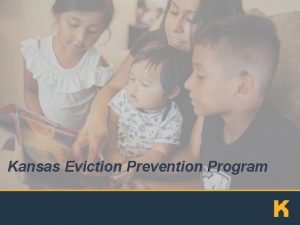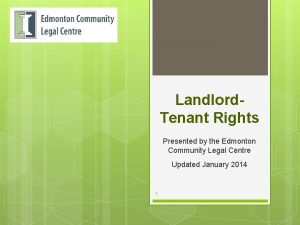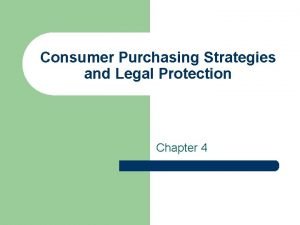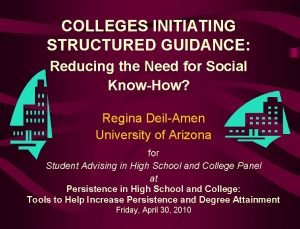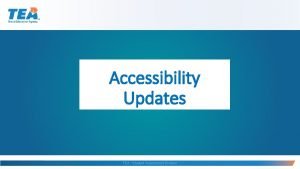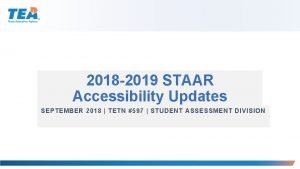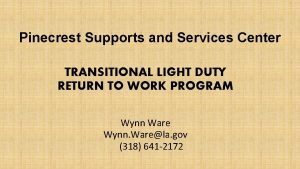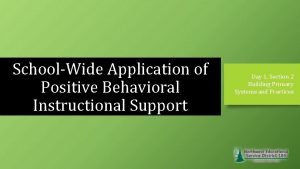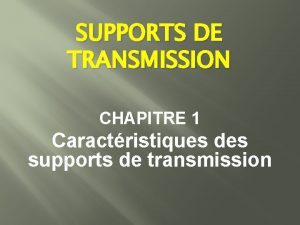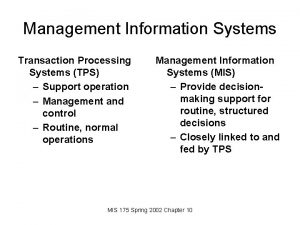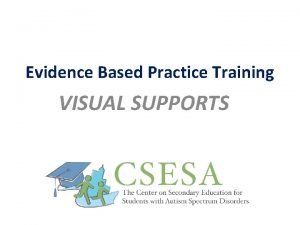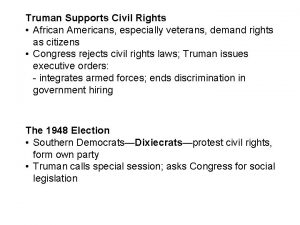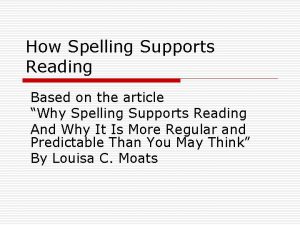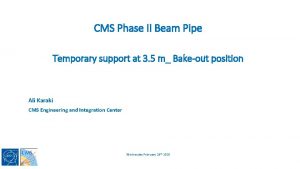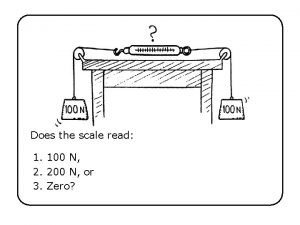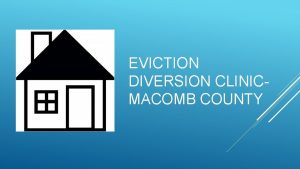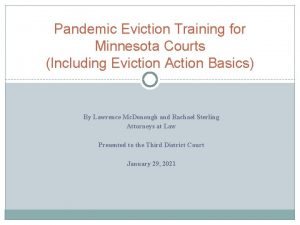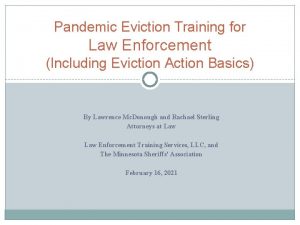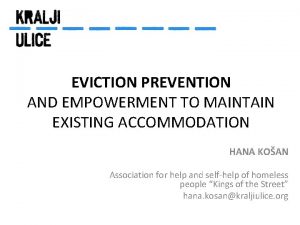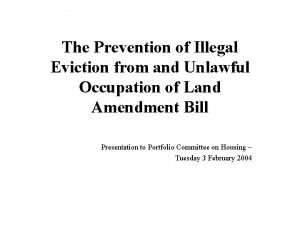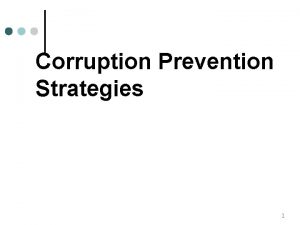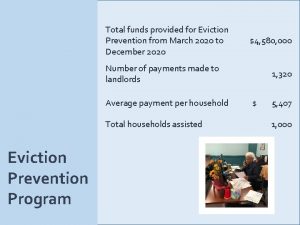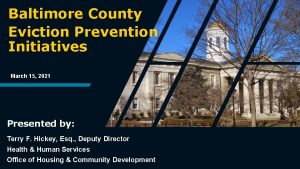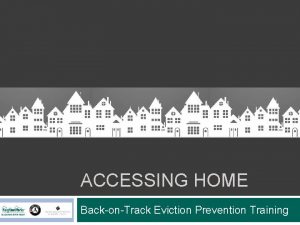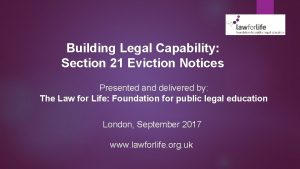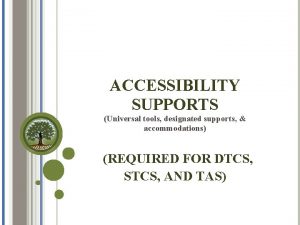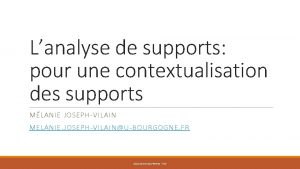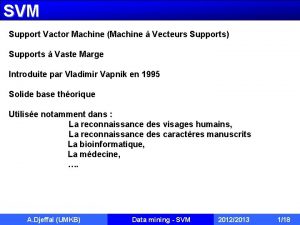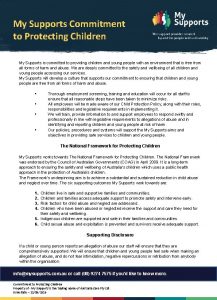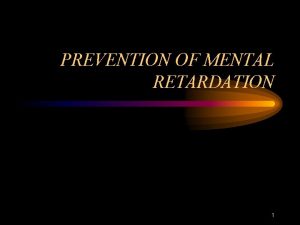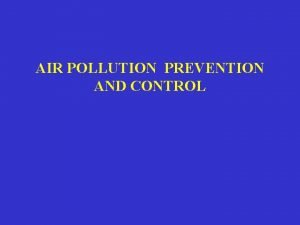Legal Supports or Strategies in Eviction Prevention and


















![Tenants Behind on Rent “According to [Community Housing Improvement Program (CHIP)’s] self -reported surveys Tenants Behind on Rent “According to [Community Housing Improvement Program (CHIP)’s] self -reported surveys](https://slidetodoc.com/presentation_image_h2/22d764e0ebf86696f410041f450e0d89/image-19.jpg)





















- Slides: 40

Legal Supports or Strategies in Eviction Prevention and Housing Retention During and After COVID-19 LAWRENCE R. MCDONOUGH ATTORNEY AT LAW PRESENTED AT THE HOMELESS AND HOUSING RESOURCE CENTER WEBINAR: EVICTION PREVENTION AND HOUSING RETENTION DURING AND AFTER COVID-19 DECEMBER 16, 2020 REVISED DECEMBER 17, 2020

Presenter Lawrence Mc. Donough Attorney at Law Adjunct Professor of Law, University of Minnesota School of Law Senior Minnesota Counsel, Lawyers' Committee for Civil Rights Under Law 651 -398 -8053 mcdon 056@umn. edu http: //povertylaw. homestead. com/Biolarrymcdonough. html Housing Law in Minnesota http: //povertylaw. homestead. com/Housing. Lawin. Minnesota. html

State Eviction Suspensions Some states have suspended some evictions. More states let their suspensions expire, or never had one. E. Benfer, COVID-19 Eviction Moratoria: Federal (CDC), State, Commonwealth, and Territory (viewed Dec. 9, 2020) https: //docs. google. com/spreadsheets/u/1/d/e/2 PACX 1 v. TH 8 d. UIbfnt 3 X 52 Tr. Y 3 d. EHQCAm 60 e 5 nqo 0 Rn 1 r. NCf 15 d. PGe. Xx. M 9 QN 9 Udx Uf. Ejxwvf. TKzb. Cb. Zx. JMd. R 7 X/pubhtml COVID-19 Housing Policy Scorecard (Eviction Lab - viewed Dec. 9, 2020) https: //evictionlab. org/covid-policy-scorecard/

Minnesota Eviction Suspension: Executive Order 20 -79 It remains in effect until the peacetime emergency declared in Executive Order 20 -01 is terminated or until it is rescinded by proper authority. Prohibits evictions and lease terminations, with exceptions (listed in notes). Nonpayment of rent is not an exception. Does not affect late fees.

CARES Act § 4024: https: //library. nclc. org/sec-4024 -temporary-moratorium-eviction-filings https: //library. nclc. org/major-consumer-protections-announced-response-covid 19#content-1 Applies only to covered properties: federal public and subsidized housing, and rental properties with federally backed mortgages Prohibited late fees from March 27 through July 25, 2020 Requires 30 -day lease termination notice given July 25, 2020 or afterward for all eviction bases with no expiration date

CDC Eviction Suspension Order: https: //www. cdc. gov/coronavirus/2019 -ncov/covid-eviction-declaration. html https: //www. cdc. gov/coronavirus/2019 -ncov/downloads/eviction-moratoria-orderfaqs. pdf Effective until December 31, 2020 "Residential property" is defined to include "any property leased for residential purposes, " and goes on to specify the term includes "any house, building, mobile home or land in a mobile home park, or similar dwelling leased for residential purposes. " Exception: any hotel, motel, or other guest house rented to a temporary guest or seasonal tenant" as defined under state law. There are exceptions to Eviction Suspension Order, including criminal activity, damaging property, and violating building codes (full list in notes).

CDC Eviction Suspension Order Tenant must provide a required declaration, sworn under penalty of perjury, to the landlord: (1) used best efforts to obtain all available government assistance; (2) limited income; (3) unable to pay my full rent or make a full housing payment due to substantial loss of household income, loss of compensable hours of work or wages, lay-offs, or extraordinary out-of-pocket medical expenses; (4) using best efforts to make timely partial payments that are as close to the full payment as the individual's circumstances may permit, taking into account other nondiscretionary expenses; (5) risk of homelessness; and (6) understand rent obligation. Form: https: //www. cdc. gov/coronavirus/2019 ncov/downloads/declaration-form. pdf Resources available from the National Housing Law Project and National Low Income Housing Coalition

Financial Assistance for Tenants State and Local Rental Assistance (National Low Income Housing Coalition - viewed Dec. 9, 2020) https: //nlihc. org/rental-assistance

Expiration of Minnesota Executive Order 20 -79 and the CDC Eviction Suspension Order will leave some properties governed by: The CARES Act § 4024: requires 30 -day lease termination notice given July 25, 2020 or afterward for all eviction bases with no expiration date for covered properties Order Continuing Operations of the Minnesota Judicial Branch under Emergency Executive Order No. 20 -33 has no expiration date. Local orders may stay in effect. House File No. 4556, Art. 1, § 16 continues suspension of statutory deadlines for court proceedings until 60 days after the end of the peacetime emergency declaration or February 15, 2021, whichever is earlier.

The Minnesota Eviction Tsunami 16, 000 eviction court actions were filed in Minnesota in 2017, or 1, 333 per month. There around 6, 000 annual eviction actions in Hennepin County, or 500 per month. 3, 000 evictions per year are for tenants in Minneapolis, or 250 per month. In 2019, Anoka County had 1080 eviction cases, or 90 per month.

The Minnesota Eviction Tsunami If the suspension were to end December 31, it will have been in place for a little more than 8 months. With no other factors present, on January 1, 2121, 10, 667 would be on hold statewide (4, 000 in Hennepin County, 2, 000 in Minneapolis, and 720 in Anoka County), or 8 times the pre-virus monthly number of evictions. Some tenants have moved, some have negotiated with their landlords, and some have received assistance, perhaps lowering the number, if the economy is ignored. But, what about economy?

Tenants Already Were Rent Burdened Cost Burdens Rise for Middle-Income Households in Most Metros (Harvard Joint Center for Housing Studies January 2020) https: //www. jchs. harvard. edu/cost-burdens-rise-middleincome-households-most-metros M. Moylan, Report: More Middle-income Renters Burdened by Housing Costs (Minnesota Public Radio Jan. 31, 2020) https: //www. mprnews. org/story/2020/01/31/report-moremiddleincome-renters-burdened-by-housing-costs Housing Burden: All Residents Should Have Access to Quality, Affordable Homes (National Equity Atlas) https: //nationalequityatlas. org/indicators/Housing_burden#/ American Families Face a Growing Rent Burden - High Housing Costs Threaten Financial Security and Put Homeownership out of Reach for Many (The Pew Charitable Trusts April 19, 2018) https: //www. pewtrusts. org/en/research-and-analysis/reports/2018/04/americanfamilies-face-a-growing-rent-burden

Minnesota Tenants Already Were Rent Burdened The percent of occupied units paying rent that are spending more than 30% of income on rent costs in selected counties in Minnesota: Hennepin County: 47. 1% Ramsey County: 49. 4% Anoka County: 46. 5% Stevens County: 54. 1% Itasca County: 54. 1% Waseca County: 54. 2% Wilkin County: 55. 0% Clay County: 55. 7%

Unemployment in Minnesota Unemployment is high. The Minnesota unemployment rate in October was 4. 6. %, down from 7. 4% in August, while in May it was 9. 9%, up from 2. 9% in March. State and National Employment and Unemployment Current Data (Minnesota Department of Employment and Economic Development - viewed Dec. 9, 2020) https: //mn. gov/deed/data/current-econ-highlights/state-nationalemployment. jsp Minnesota Unemployment (Department of Numbers - viewed Dec. 9, 2020) https: //www. deptofnumbers. com/unemployment/minnesota/

Unemployment in Minnesota cumulative unemployment insurance applicants by county from March 16 to December 9, 2020 as a share of 2019 annual labor force: Hennepin County: 36. 6% Ramsey County: 37. 7% Anoka County: 38. 3% Cook County: 49. 1% Mahnomen County: 49. 4% Roseau County: 69. 5%

Unemployed Tenants Around the Country In April 2020, Supermajority News reported: “‘We find that renters have both a higher unemployment rate and that their income fluctuates from month to month, ’ Jung Hyun Choi, a research associate with the Housing Finance Policy Center at the Urban Institute, told Supermajority News. Renters are more likely to be hourly workers — The 2018 American Community Survey by the Census Bureau found 23 percent of renters worked in industries like retail, hospitality, and restaurants. As Choi noted, ‘those kinds of jobs are more susceptible to unemployment. ’”

Unemployed Tenants Around the Country In September 2020, the Pew Research Center reported: “Among lower-income adults, 46% say they have had trouble paying their bills since the pandemic started and roughly one third (32%) say it’s been hard for them to make rent or mortgage payments. ” “About one-in-five or more adults ages 18 to 29 (25%) and 30 to 49 (21%) have had trouble paying their rent or mortgage. ” “ 27% of those who have experienced job loss or a pay cut in their household had problems paying their rent or mortgage. . . ”

Unemployed Tenants Around the Country On October 5, 2020, in Massachusetts, the Metropolitan Area Planning Council estimated that with the August unemployment rate being 11. 3%, “ 125, 000 of the claims filed during the week ending on September 5 were filed by workers in renter households (37. 4% of all claims). ” It noted that the “The Census Bureau Pulse survey indicates that nearly one in six renters in Massachusetts are already behind on their rent payments and one in five were not confident they could pay October rent. ”
![Tenants Behind on Rent According to Community Housing Improvement Program CHIPs self reported surveys Tenants Behind on Rent “According to [Community Housing Improvement Program (CHIP)’s] self -reported surveys](https://slidetodoc.com/presentation_image_h2/22d764e0ebf86696f410041f450e0d89/image-19.jpg)
Tenants Behind on Rent “According to [Community Housing Improvement Program (CHIP)’s] self -reported surveys of its membership, an average of 8% of renters don’t pay rent in normal times. During the coronavirus crisis to date, that share has gone up to 15 to 20% of renters not paying. In California, the total rent collected from Class C renters (those in properties typically more than 20 years old, which are often in need of updating) dropped 35% from June to July alone—from 59% in June to 24% in July—according to a recent Lease. Lock report. Those figures are down from 85% in January, showing that these renters, who are already more vulnerable, are seeing the deepest financial strain. ”

Census Data: Tenants, Unemployment, and Rents The United States Census Bureau produces data on the social and economic effects of coronavirus on American households. The Household Pulse Survey collects data to measure household experiences during the coronavirus pandemic. Measuring Household Experiences during the Coronavirus Pandemic, Household Pulse Survey – Phase 3 (October 28, 2020 – December 21, 2020) (United States Department of Commerce - viewed Dec. 9, 2020) https: //www. census. gov/data/experimental-data-products/household-pulsesurvey. html

Census Data: Tenants, Unemployment, and Rents The tables below show data that were collected from November 11 through November 23. • Table 1 a. Last Month's Payment Status for Owner Occupied Housing Units, by Select Characteristics • Table 1 b. Last Month's Payment Status for Renter Occupied Housing Units, by Select Characteristics • Table 2 a. Confidence in Ability to Make Next Month's Payment for Owner Occupied Housing Units, by Select Characteristics • Table 2 b. Confidence in Ability to Make Next Month's Payment for Renter Occupied Housing Units, by Select Characteristics • Table 3 a. Likelihood of Having to Leave this House in Next Two Months Due to Foreclosure, by Select Characteristics • Table 3 b. Likelihood of Having to Leave this House in Next Two Months Due to Eviction, by Select Characteristics Week 19 Household Pulse Survey: November 11 – November 23 (United States Department of Commerce Dec. 2, 2020, viewed Dec. 9, 2020) https: //www. census. gov/data/tables/2020/demo/hhp 19. html

Census Data on Minnesota Tenants, Unemployment, and Rents The Census Bureau Household Pulse Survey showed that in Minnesota through November 23, 2020, of 713, 083 adult tenants surveyed: • 77, 329 (10. 8%) reported that they were not currently caught up on rent payments, • 234, 077 (32. 8%) reported they were unemployed, and • 417, 658 (58. 9%) reported loss of employment income of a household member. The survey sample is strong. In 2019, there were 611, 160 renter households in Minnesota.

Census Data on Minnesota Tenants and Rents When asked about confidence to pay the next month’s rent: 32, 959 (4. 6%) occupied housing without rent 1, 823 (0. 2%) reported deferred rent 80, 298 (11. 3%) reported no confidence 148, 685 (20. 9%) reported slight confidence 119, 154 (16. 8%) reported moderate confidence Only 330, 163 (46. 3%) reported high confidence 228, 983 (31. 1%) reported no or slight confidence

Census Data on Risk of Eviction in Minnesota Of the 77, 329 adult tenants who reported that they were not currently caught up on rent payments, when asked about the likelihood of leaving this home due to eviction in next two months: 39, 989 (51. 7%) responded not likely at all 19, 197 (24. 8%) responded not very likely 7, 299 (9. 4%) responded somewhat likely 10, 845 (14. 0%) responded very likely 18, 144 (23. 4%) responded very likely or somewhat likely Note that these tenants were assessing the risk of eviction while Executive Order 20 -79 has suspended evictions for nonpayment of rent.

People of Color Are at Great Risk of Eviction in Minnesota In October 2020, the 6 -month moving average unemployment rate for Minnesota was 7. 1%, up from 2. 8% in October 2019. The rate for Minnesota African Americans was 15. 4%, over twice the overall rate and almost three times higher the 5. 3% rate for African Americans in October 2019. It is reasonable to assume that the unemployment rate for African American tenants is higher than the 32. 8% rate of unemployment for Minnesota tenants in general. Of 83, 768 adult African Americans tenants asked about confidence to pay the next month’s rent, 51, 980 (62. 1%) of African Americans reported no or slight confidence. Of the 14, 143 adult African Americans tenants who reported that they were not currently caught up on rent payments, when asked about the likelihood of leaving this home due to eviction in next two months, 100% of African Americans responded very likely or somewhat likely.

Homelessness in Minnesota Homelessness already had reached a record high in Minnesota before the pandemic. During the pandemic, the county costs of housing the homeless has skyrocketed. Attorney representation of tenants increases favorable outcomes for tenants, reduces the risk of homelessness, and reduces government emergency financial assistance and shelter costs.

Minnesota Eviction Estimates Stout estimates for Minnesota, surveyed November 11 to 23, 2020: 92, 000 -199, 000 at risk of eviction $142, 000 -$267, 000 current shortfall 32, 100 -69, 800 potential evictions in January $173, 000 -$330, 000 January rent shortfall Estimation of Households Experiencing Rental Shortfall and Potentially Facing Eviction (Stout Risius Ross - viewed Dec. 9, 2020) https: //app. powerbi. com/view? r=ey. Jr. Ijoi. Nz. Rh. Yjg 2 Nz. At. MGE 1 MC 00 Nm. Nj. LTll. OTMt Yj. M 2 Nj. Fm. OTA 4 Zj. My. Iiwid. CI 6 Ijc 5 MGJm. Njk 2 LTE 3 NDYt. NGE 4 OS 1 h. Zj. I 0 LTc 4 ZGE 5 Y 2 Rh. ZGE 2 MSIs. Im. Mi. Oj. N 9

Minnesota Eviction Estimates In June 2020, the Aspen Institute estimated nationally, that if the tenant “unemployment rate is 25 percent, 19 million people would be at risk of eviction by September 30, as their unemployment benefits expire, stimulus payments are spent, and savings dwindle; that rises to 23 million if renters’ unemployment rate is 30 percent. ” It concluded the risk of eviction at 30% renter unemployment for Minnesota on December 31, 2020 would be 281, 085 tenants.

Minnesota Eviction Estimates While the national estimates of eviction in Minnesota might be high, the high unemployment rate among tenants, high rent burden, and limited financial assistance indicate that the eviction numbers will be considerably higher than before the pandemic. Remember the Census data. Out of 713, 083 adult tenants surveyed, 77, 329 (10. 8%) reported that they were not currently caught up on rent payments, 234, 077 (32. 8%) reported unemployment, 417, 658 (58. 9%) reporting loss of employment income, and 228, 983 (31. 1%) reported no or slight confidence to pay the next month’s rent. Of the 77, 329 adult tenants who reported that they were not currently caught up on rent payments, when asked about the likelihood of leaving this home due to eviction in next two months, 18, 144 (23. 4%) responded very likely or somewhat likely Compare this with 16, 000 eviction court actions in 2017.

Minnesota Eviction Estimates When I managed the housing unit of Mid-Minnesota Legal Aid covering Hennepin County, I regularly handled 300 cases a year, but most of those were advice cases. At my high point of my work as a staff attorney, I went to court three to five times a week and handled one to two trials a month. The MMLA housing unit currently includes 14. 5 attorneys, providing full representation to a range of 15 -30 per month in Hennepin County. A very conservative estimate of possibly of over ten times the pre-pandemic number of evictions when nonpayment of rent evictions start could result in 13, 330 eviction court actions statewide, with 5, 000 in Hennepin County, 2, 500 in Minneapolis, and 720 in Anoka County for the first month, with similar percentage increases in counties throughout the state, overwhelming the legal services housing attorneys.

Health Impact of Renewed Evictions During the Pandemic One study concluded: “Our model predicts that even for lower eviction rates that don’t dramatically change the population-level epidemic burden, the individual risk of infection was always substantially higher for those who experienced eviction, or who merged households with those who did. . However, the increased risk of infection was not only felt by those who doubled-up: for individuals who were neither evicted nor merged households with those who did, the risk of infection relative the counterfactual scenario of no evictions was 1. 05 for an eviction rate of 0. 25%/month and 1. 5 for 2. 0% evictions per month. . This increased risk highlights the spillover effects of evictions on the wider epidemic in a city. ”

Health Impact of Renewed Evictions During the Pandemic One on the study authors described it at a recorded seminar on September 8, 2020. The modeling study from the Johns Hopkins University Institute for Computational Medicine and University of Pennsylvania Perelman School of Medicine found that when tenants are evicted, they often move in with other family members, increasing the size of households and the chance for viral transmission, and concluding that policies to stem evictions are a warranted and important component of COVID-19 control. The model did not include the effect of homelessness in shelters and encampments.

Health Impact of Renewed Evictions During the Pandemic Another study found a connection between eviction and health outcomes, and concludes that eviction prevention, through moratoria and other supportive measures, is a key component of a pandemic control strategy to mitigate COVID-19 spread and death.

Health Impact of Renewed Evictions During the Pandemic Yet another study tested whether lifting eviction moratoriums was associated with COVID-19 incidence and mortality. It concluded that “[l]ifting eviction moratoriums was associated with significant increases in COVID-19 incidence and mortality in U. S. states, supporting the public health rationale for use of eviction moratoriums to prevent the spread of COVID-19. Lifting moratoriums amounted to an estimated 433, 700 excess cases and 10, 700 excess deaths during the study period (March 13 -September 3). ”

Health Impact of Renewed Evictions During the Pandemic The study included a table of estimated infections and deaths in states that ended their eviction suspensions. Texas topped the list with estimates of 148, 530 infections and 4, 456 deaths. Id. at 14. Comparing states with populations similar to Minnesota can suggest the number of infections and deaths that were prevented by maintaining Executive Order 20 -79 and its predecessors.

Health Impact of Renewed Evictions During the Pandemic A: July 1, 2019 Estimated Population B: Date Eviction Suspension Ended C: Weeks End of Suspension to September 3, 2020 D: Estimated Excess Virus Cases after Date Eviction Suspension Ended E: Estimated Excess Virus Deaths after Date Eviction Suspension Ended State A B C D E Maryland 6, 045, 680 July 25, 2020 6 2, 310 37 Wisconsin 5, 822, 434 May 26, 2020 14 19, 840 346 Colorado 5, 758, 736 June 13, 2020 12 8, 620 254 Minnesota 5, 639, 632 Eviction suspension maintained South Carolina 5, 148, 714 May 14, 2020 16 37, 590 1, 090 Alabama 4, 903, 185 May 31, 2020 14 26, 470 621 Louisiana 4, 648, 794 June 15, 2020 12 29, 650 959

Health Impact of Renewed Evictions During the Pandemic Study co-author Dr. Leifheit has estimated infections prevented and lives saved between May and September in states that maintained their eviction suspensions. State Arizona California Connecticut D. C. Florida Hawaii Illinois Massachusetts Cases Prevented by Suspension 63, 700 186, 600 17, 100 3, 900 197, 700 2, 200 63, 200 31, 800 Deaths Prevented by Suspension 2, 540 6, 520 170 6, 140 30 2, 670 2, 400

Health Impact of Renewed Evictions During the Pandemic State Minnesota Montana Nevada New Jersey New Mexico New York Oregon Vermont Washington TOTAL Cases Prevented by Suspension 22, 200 2, 100 16, 400 53, 000 6, 800 135, 000 6, 200 600 18, 400 826, 900 Deaths Prevented by Suspension 680 60 580 3, 940 310 10, 230 180 20 740 38, 730 Note that this estimate does not cover the fall of 2020 when many states saw dramatic increases in infections and deaths.

What Can You Do? Refer, Volunteer and Donate Free Legal Aid Programs Representing Tenants: Law Help https: //www. lawhelp. org/find -help Housing Litigation and Policy Advocacy: National Housing Law Project https: //www. nhlp. org/ National Low Income Housing Coalition https: //nlihc. org/ Advocate: United States: President Elect, Senate, House of Representatives, Centers for Disease Control and Prevention (CDC), Department of Housing and Urban Development (HUD) States: Governors, Legislators, Housing Agencies, Health Agencies, Courts Localities: County Boards and Agencies, City Mayors, Councils, and Agencies

Questions Lawrence Mc. Donough Attorney at Law Adjunct Professor of Law, University of Minnesota School of Law Senior Minnesota Counsel, Lawyers' Committee for Civil Rights Under Law 651 -398 -8053 mcdon 056@umn. edu http: //povertylaw. homestead. com/Biolarrymcdonough. html Housing Law in Minnesota http: //povertylaw. homestead. com/Housing. Lawin. Minnesota. html
 Kansas eviction prevention program 2021
Kansas eviction prevention program 2021 Primary prevention secondary prevention tertiary prevention
Primary prevention secondary prevention tertiary prevention Constructive eviction definition
Constructive eviction definition Landlord harassment alberta
Landlord harassment alberta Eviction diversion program richmond va
Eviction diversion program richmond va Consumer purchasing strategies and legal protection
Consumer purchasing strategies and legal protection Smacna hangers and supports
Smacna hangers and supports Oral administration staar 2020
Oral administration staar 2020 What are content and language supports
What are content and language supports Structured guidance and supports
Structured guidance and supports Accessibility features staar
Accessibility features staar Staar content and language supports
Staar content and language supports Metacognition and growth mindset supports grit.
Metacognition and growth mindset supports grit. Pinecrest supports and services center
Pinecrest supports and services center Positive behavioral interventions and supports
Positive behavioral interventions and supports Positive behavioral interventions and supports
Positive behavioral interventions and supports Supports intensity scale rating key
Supports intensity scale rating key Support de transmission
Support de transmission Short response questions
Short response questions Snmp osi model
Snmp osi model Tps support
Tps support Explain operating modes of 80386
Explain operating modes of 80386 Visual supports evidence based practice
Visual supports evidence based practice Composite pipe supports
Composite pipe supports Truman supports civil rights
Truman supports civil rights An opinion paragraph example
An opinion paragraph example Title 22 rcfe prohibited conditions
Title 22 rcfe prohibited conditions Cirilo bautista background
Cirilo bautista background How spelling supports reading
How spelling supports reading The pipe assembly supports the vertical loads shown
The pipe assembly supports the vertical loads shown Raceway supports
Raceway supports Preext
Preext What are the components of accenture delivery suite (ads)?
What are the components of accenture delivery suite (ads)? What is the name
What is the name Body tube microscope
Body tube microscope Where can a variable be assigned values in pl/sql mcq
Where can a variable be assigned values in pl/sql mcq Does the scale read 100 n
Does the scale read 100 n What is the author's purpose in this paragraph
What is the author's purpose in this paragraph Amerigroup fcs
Amerigroup fcs Microscope parts and functions
Microscope parts and functions At four hundred miles they stopped to eat
At four hundred miles they stopped to eat
